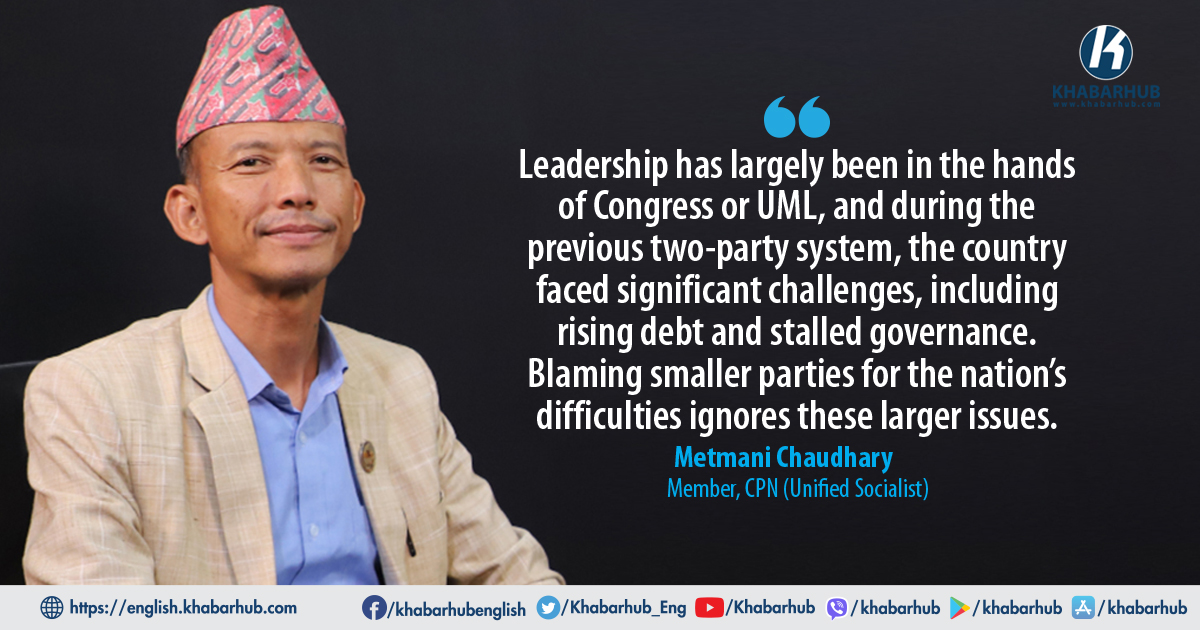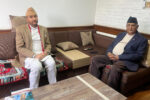KATHMANDU: Many observers believe that the alliance between Nepal’s two largest parties, the Nepali Congress and the CPN-UML, is paving the way for a two-party system.
The global practice of electoral thresholds is often seen as a means to stabilize the political system, but in the context of Nepal, the threshold’s purpose and application are crucial concerns.
There is growing apprehension that if these major parties succeed in raising the threshold from the current 3 percent to 10 percent, the influence of smaller political parties in Nepal’s national, central, and provincial politics could diminish significantly.
Critics worry that increasing the threshold might lead to a more authoritarian system, marginalizing smaller parties and limiting democratic diversity.
Here is an edited excerpt from Krishna Timalsina’s conversation with Metmani Chaudhary, Chief Whip of the CPN Unified Socialist, on this issue:
The Nepali Congress-UML alliance has initiated a debate over amending the law to raise the electoral threshold to 10 percent. What is your response to those parties that have failed to achieve national party status under the current three percent threshold?
The threshold for national party recognition should be set at a reasonable level to ensure representation.
The percentage required to win direct elections need not be excessively high.
Recently, there has been a trend towards governance by a limited number of dominant parties, reminiscent of past practices where a majority system or large parties monopolized power.
Our vision is to establish a socialist model. We emphasize the need to build the country, uphold democracy, and engage the people.
It appears this new proposal aims to reestablish such a system.
Such a move threatens to undermine Nepal’s inclusive democracy, which is a cornerstone of our constitution.
In my view, if a party seeks to be dominant, it could set a threshold of 50 percent or 40 percent.
Centralizing policy and setting an arbitrary threshold to marginalize smaller parties is problematic.
This effort seems to be an attempt to weaken the principles of inclusive democracy.
What do you think should be done in Nepal, considering global practices?
Our current practice emphasizes inclusive democracy, which is vital for integrating marginalized groups into the nation’s mainstream.
The Constitution mandates 33 percent representation for women and 11 percent for Dalits, reflecting the diversity of Nepal’s population.
This inclusion was not present in the past, but now our democracy enables all citizens to feel represented and valued.
Unfortunately, the major parties seem intent on undermining this progress, creating disillusionment among the people.
Regarding claims that small parties have hindered the country’s progress, how many parties have governed since 2015?
Leadership has largely been in the hands of Congress or UML, and during the previous two-party system, the country faced significant challenges, including rising debt and stalled governance. Blaming smaller parties for the nation’s difficulties ignores these larger issues.
Is it not true that even a small number of seats can affect democratic integrity?
During the era of only two dominant parties, the country struggled with stability and effective governance.
Even with a majority or two-thirds control, governments frequently failed to last. Issues like corruption and political misconduct have damaged the country’s international image, and the Congress-UML alliance seems to be deflecting from these problems.
Reflecting on your time in the CPN-UML, how was the 10 percent threshold viewed then?
At that time, we were not in a position to influence policy significantly.
KP Oli’s focus was on consolidating power for himself. While I take moral responsibility for my past role in the UML, my influence on policy-making was limited.
Was there any notable opposition to the threshold increase from within the party?
The goal should be to ensure broad political participation and representation.
Creating an environment dominated by only two parties would be a mistake.
Such an approach is shortsighted and contrary to the principles of inclusive democracy.
Given the challenges faced since the CPN-UML split, where do you see your party’s future?
Political parties evolve, and new and old members come and go. The key factor is whether a party can address issues effectively and resonate with the people.
If we can meet these challenges, our party will grow. If not, we face natural political shifts.
What is your agenda now?
There was talk about appointing Madhav Kumar Nepal as the Chairman, and we followed through with that plan.
However, despite identifying ourselves as communists, there is no clear plan from any so-called communist party regarding the future course of action.
There is a prevailing sentiment among the people and within our party that Madhav Nepal’s leadership is still necessary and relevant.
Our vision is to establish a socialist model. We emphasize the need to build the country, uphold democracy, and engage the people.
There should be a strategic plan to integrate these elements effectively.
Can you say that you initiated this from within the government?
In the absence of a convention, we proceeded in an ad-hoc manner.
We entered the government with minimal representation and were not in a position to lead effectively.
Consequently, people may not have fully believed in our efforts.
Despite the challenges, we have made a start in constructing a state system based on a socialist model.
Madhav Nepal and Jhalanath Khanal, who have been associated with the CPN-UML leadership, are now part of your team. How can you believe that transformation is possible after forming the Samajwadi Party, when previous efforts within UML did not achieve this?
We all come from a CPN-UML background, with some members influenced by Marxist ideas.
Alongside the Maoists, we initially formed the Nepal Communist Party.
When Madhav Nepal served as Prime Minister from CPN-UML, his leadership was marked by significant public welfare initiatives.
Despite various analyses of contemporary leaders, Madhav Nepal’s tenure is seen as a period of progress. He needs another opportunity to continue this work.
Wasn’t it time to move beyond the Madhav Nepal generation?
There is a prevailing sentiment among the people and within our party that Madhav Nepal’s leadership is still necessary and relevant.
What about the possibility of reconciling with UML?
Under no circumstances are we compatible with the CPN-UML.









Comment